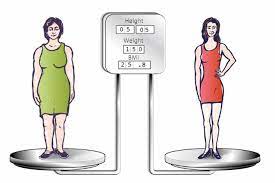Confused about BMI vs. body composition? This article explains the difference, importance, and limitations of each in assessing health and fitness.
Are you confused about the difference between BMI and body composition? You’re not alone! Many people use these terms interchangeably, but they actually refer to two different things when it comes to assessing your health and fitness. BMI, or Body Mass Index, is a measure of your weight in relation to your height and is commonly used to categorize individuals as underweight, normal, overweight, or obese. On the other hand, body composition refers to the ratio of fat, muscle, and other tissues in your body. This article will help you understand the distinction between the two and why it’s important to consider both when evaluating your overall health.
Understanding the Distinction: BMI vs. Body Composition
When it comes to assessing and understanding our bodies, two terms often come up: BMI (Body Mass Index) and body composition. While they may seem similar, they actually offer different insights into our overall health and wellbeing. In this article, we will explore the definitions, calculations, limitations, and importance of both BMI and body composition, helping you gain a better understanding of these crucial measurements.
Definition of BMI
BMI, or Body Mass Index, is a commonly used measurement to determine if someone falls within a healthy weight range for their height. It is calculated by dividing a person’s weight (in kilograms) by the square of their height (in meters). The result is a number that falls into one of the BMI categories, such as underweight, normal weight, overweight, or obese. BMI is widely used because it provides a simple and quick way to classify people into different weight-related categories.
Definition of Body Composition
Body composition, on the other hand, refers to the ratio of fat, muscle, bone, and water in our bodies. Unlike BMI, which only considers weight and height, body composition looks deeper into the different components that make up our bodies. By analyzing body composition, we can gain a more accurate understanding of our overall health, including the distribution of fat and muscle in our bodies.
History and Purpose
BMI was developed in the early 19th century as a way to classify people’s weight categories based on statistical analysis. Its purpose was to provide a simple and standardized method for assessing weight-related health risks at a population level. On the other hand, body composition analysis has been around for many years but has gained prominence in recent decades due to advancements in technology and research. Its purpose is to provide individuals with a more detailed understanding of their bodies’ composition and guide them in making informed decisions about their health and fitness goals.
Calculation
Calculating BMI is relatively straightforward. You divide your weight (in kilograms) by the square of your height (in meters). The result is your BMI score. For example, if you weigh 70 kilograms and your height is 1.75 meters, your BMI would be calculated as follows: 70 / (1.75 * 1.75) = 22.86.
Body composition, on the other hand, requires more advanced techniques for measurement. While methods may vary, they generally involve the use of sophisticated equipment such as dual-energy X-ray absorptiometry (DEXA), bioelectrical impedance analysis (BIA), or skinfold calipers. These methods allow for a more accurate assessment of the different components of the body, such as fat mass, lean muscle mass, and bone density.
Issues with BMI
While BMI provides a quick and simple way to classify weight-related health risks, it does have its limitations. One of the main issues with BMI is that it does not take into account individual variations in body composition. For example, two individuals with the same BMI score may have completely different body compositions, with one having a higher percentage of muscle and the other having a higher percentage of fat.
Limitations of BMI
In addition to not considering body composition, BMI also fails to take into account other factors that may influence health risks, such as age, sex, and ethnicity. It is a one-size-fits-all measurement that does not provide personalized insights into an individual’s health. Furthermore, BMI does not differentiate between different types of fat, such as visceral fat (around the organs) and subcutaneous fat (under the skin), which carry different health risks.
Interpreting BMI Results
Interpreting BMI results requires an understanding of the different categories associated with BMI scores. Generally, a BMI below 18.5 is considered underweight, 18.5-24.9 falls under the normal weight range, 25-29.9 is classified as overweight, and a BMI of 30 or above is considered obese. It is important to note that BMI is just one measurement and should not be the sole factor in determining an individual’s overall health status.
Advantages of BMI
Despite its limitations, BMI does have some advantages. Its simplicity and ease of calculation make it accessible to a wide range of individuals and healthcare professionals. It is also useful in large-scale epidemiological studies that require quick and standardized measurements for population health analysis. Additionally, BMI can serve as a starting point for discussions about weight-related health risks and can prompt individuals to seek further assessments and advice from healthcare professionals.
Importance of Body Composition
While BMI has its merits, body composition plays a crucial role in understanding our bodies’ overall health and wellness. It takes into account the different components that make up our bodies, providing a more complete picture than BMI alone. By assessing body composition, we can gain insights into the distribution of fat and muscle mass, which are key indicators of health and disease risk.
Components of Body Composition
Body composition consists of several components, including fat mass, lean muscle mass, bone mass, and water content. Fat mass refers to the amount of fat in the body and is categorized as essential fat (needed for normal physiological function) and non-essential fat (excess fat that serves as energy storage). Lean muscle mass includes muscles, organs, and tissues and is associated with strength, metabolism, and overall health. Bone mass represents the weight and density of bones, which is crucial for skeletal health. Finally, water content is an essential component of body composition, playing a vital role in various bodily functions.
Measuring Body Composition
Measuring body composition requires specialized techniques and equipment. Common methods include dual-energy X-ray absorptiometry (DEXA), which uses X-rays to measure bone density and estimate body composition, bioelectrical impedance analysis (BIA), which sends a low electrical current through the body to estimate body fat percentage, and skinfold calipers, which measure the thickness of skinfolds at different body sites to estimate body fat percentage. Each method has its strengths and limitations, and the choice of method depends on factors such as availability, cost, and accuracy.
Methods for Assessing Body Composition
There are various methods available for assessing body composition, each with its own advantages and disadvantages. Aside from the aforementioned DEXA, BIA, and skinfold calipers, other methods include hydrostatic weighing (underwater weighing), air displacement plethysmography (Bod Pod), and infrared interactance. Each method offers different levels of accuracy and is suitable for different populations and research purposes.
Determining Ideal Body Composition
Ideal body composition is highly individualized and depends on factors such as age, sex, genetics, and lifestyle. There is no one-size-fits-all approach, as optimal body composition may vary based on individual goals and health conditions. Generally, having a healthy amount of lean muscle mass and a lower percentage of body fat is associated with better overall health and reduced risk of chronic diseases.
Importance of Body Composition in Health
Understanding body composition is crucial for maintaining good health and preventing lifestyle-related diseases. Research has consistently shown that an excess amount of body fat, particularly visceral fat, is associated with an increased risk of conditions such as cardiovascular disease, type 2 diabetes, and certain types of cancer. By analyzing body composition, individuals can make informed decisions about their diet, exercise, and overall lifestyle to optimize their health and minimize health risks.
Individual Differences
It is important to recognize that individuals have unique body compositions, and what may be considered healthy for one person may not be the same for another. Factors such as genetics, age, sex, and lifestyle play significant roles in determining an individual’s body composition and health. Therefore, focusing on personalized assessments and goals is essential for promoting long-term health and wellbeing.
Relationship between BMI and Body Composition
While BMI and body composition are two separate measurements, they are not entirely disconnected. BMI can be used as a starting point to gauge an individual’s weight status and identify potential health risks. However, it should be supplemented with a detailed analysis of body composition to provide a more comprehensive understanding of an individual’s health.
Influence of Body Composition on Health Risks
Research has shown that body composition, specifically the distribution of fat and muscle mass, has a significant impact on health risks. Excess body fat, especially visceral fat, has been linked to various health conditions, including insulin resistance, cardiovascular disease, and metabolic syndrome. On the other hand, having a higher percentage of lean muscle mass is associated with better metabolic health, improved strength and mobility, and reduced risk of chronic diseases.
Conclusion
In conclusion, both BMI and body composition offer valuable insights into our overall health and wellbeing. While BMI provides a simple and standardized method for categorizing weight-related health risks, body composition analysis delves deeper into the different components that make up our bodies, providing a more accurate understanding of our health status. By considering both measurements, individuals can make informed decisions about their diet, exercise, and lifestyle to achieve optimal health and wellness. Remember, it is essential to focus on personalized assessments and goals, as individual differences play a significant role in determining health outcomes.




